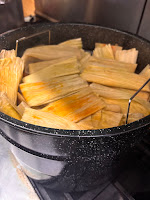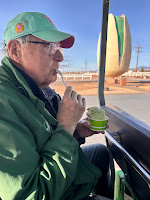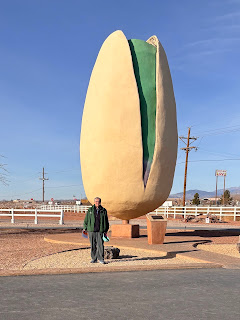THANK YOU ❤️
FA's Blog
Wednesday, March 19, 2025
Thursday, March 13, 2025
Our Usual Day…… Joe and I would get up at 6am. Our shower tiles were taped together with duct tape but we did have a private bathroom with hot water! (Luxury). Unfortunately we had a water leak - so we mopped everyday! In a few weeks we would be moving to another building so that they can renovate Casa Papa Francisco , clean up mold, asbestos.
Joe and I usually were the breakfast cooks for all our guests and volunteers. It was mainly coffee, tea, hot chocolate, oatmeal, cereal, powdered milk, white buttered toast and fresh fruit. We occasionally had eggs and pancakes. Desayuno (breakfast) was at 8am for everyone, lunch at 12:15 and dinner at 6 pm. New guests were always introduced and welcomed. A refugee woman from Venezuela or the Social Security women did most of the cooking. We had rice and beans, arapes ,tomales, soup. Every Wednesday a religious group brought in dinner for everyone. Many people would drop off bread, pastries,eggs…..El Paso community was very supportive. Our fruits, vegetables came from pantries.
After breakfast the volunteers shared meditation and reflections to start the day.
We would soon receive a report from our director as to how many guests we would receive that day and from what country. Intake forms, transportation arrangements, room assignments were made. House chores were laundry, trash, cleaning, meal preparation, etc. kept us busy always.
I proudly took over the “Roperia” the clothing store. Everyone usually needed new jeans, sweatshirts, jackets, socks, underwear, shoestrings. They came with nothing.
We had 2 shifts 7-2, 2-9. By 9 pm I was asleep….repots sent, doors locked, phones charging.
We had a big bulletin board with guest info, dates and departure notices, bus tickets, boarding passes etc.
Trump recently closed down TSA entrance for anyone without a valid passport. So travel now is mostly by bus or car.
Joe ran the clinic where he treated minor events. I taught English class, we played connect four and tv was allowed for guests in the evening.
Guests helped with chores and were expected to keep their rooms clean and prepared for next guests at their departures..most people stayed 1-3 days . Carol, our house director had a wonderful of explaining house rules to each guest. In Spanish!
Laundry was quite interesting ! We had two very old washers and a clothesline. Guests were expected to wash personal clothes by hand. Towels, sheets, blankets were constantly being washed. Occasionally we would take blankets to laundry in town. Rooms were small with a bunk bed and single bed for 3-4 people. There was a community bathroom.
Even though it was not part of our duties, Joe ended up doing a lot of transportation of guests to bus stations and airports. Our transportation service ended in January with federal funding😩
Again, we have met many wonderful people, often forced to migrate their countries and wanting a better, safer life for their families. WHAT. wOULD. I DO ?????
Tuesday, February 11, 2025
February 10, 2025
OUR NEW HOME!
Next week 10 high school students and 2 chaperones are coming from Delaware to take apart the bunk beds at Casa Papa Francisco and assemble at our new home. We will be staying at Casa Vides for six days. Casa Vides is downtown El Paso.
We have a family of 3 from Guatemala leaving for Plattsburgh, New York. We have a family of six from Venezuela waiting. We have five Social Security women also with us. Last week we had one new guest, who had just turned 18 arrive. He had come over the wall and left by Greyhound bus to Phoenix. Today Border Patrol will not be releasing any family members. Las night they were holding 115 refugees in custody and did not provide refugee encounters (detentions) for the past 24 hours in the El Paso sector. Casa Vides also provides hospitality for a number of Mexican nationals, widows of US citizens who must spend a certain amount of time each year in the US to collect Social Security benefits in which they are entitled.
February 3, 2025
" In a world filled with challenges, serving others requires courage, resilience and a deep sense of compassion. Those who approach service with an open mind and heart ( and the ability to laugh when things don't go as planned ) can create meaningful change.”
We walked over the bridge this morning at the Norte Del Paso crossing in El Paso. Bright colorful murals greeted us on the Mexican border. In contrast Barbed wire and the wall dominated the US side. Juarez was lively, colorful and full of people, food vendors, street shops and music. We slowly made our way to the Cathedral....we sampled crunchy grasshoppers, purchased salsa bowls and watched pachoukai baiarinas at the park. We had expected to serve lunch at the Cathedral but it was closed today. We had no trouble coming or going thru customs. Border patrol was present.



























